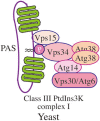The machinery of macroautophagy
- PMID: 24366339
- PMCID: PMC3879710
- DOI: 10.1038/cr.2013.168
The machinery of macroautophagy
Abstract
Autophagy is a primarily degradative pathway that takes place in all eukaryotic cells. It is used for recycling cytoplasm to generate macromolecular building blocks and energy under stress conditions, to remove superfluous and damaged organelles to adapt to changing nutrient conditions and to maintain cellular homeostasis. In addition, autophagy plays a critical role in cytoprotection by preventing the accumulation of toxic proteins and through its action in various aspects of immunity including the elimination of invasive microbes and its participation in antigen presentation. The most prevalent form of autophagy is macroautophagy, and during this process, the cell forms a double-membrane sequestering compartment termed the phagophore, which matures into an autophagosome. Following delivery to the vacuole or lysosome, the cargo is degraded and the resulting macromolecules are released back into the cytosol for reuse. The past two decades have resulted in a tremendous increase with regard to the molecular studies of autophagy being carried out in yeast and other eukaryotes. Part of the surge in interest in this topic is due to the connection of autophagy with a wide range of human pathophysiologies including cancer, myopathies, diabetes and neurodegenerative disease. However, there are still many aspects of autophagy that remain unclear, including the process of phagophore formation, the regulatory mechanisms that control its induction and the function of most of the autophagy-related proteins. In this review, we focus on macroautophagy, briefly describing the discovery of this process in mammalian cells, discussing the current views concerning the donor membrane that forms the phagophore, and characterizing the autophagy machinery including the available structural information.
Figures






Similar articles
-
How to control self-digestion: transcriptional, post-transcriptional, and post-translational regulation of autophagy.Trends Cell Biol. 2015 Jun;25(6):354-63. doi: 10.1016/j.tcb.2015.02.002. Epub 2015 Mar 8. Trends Cell Biol. 2015. PMID: 25759175 Free PMC article. Review.
-
Atg41/Icy2 regulates autophagosome formation.Autophagy. 2015;11(12):2288-99. doi: 10.1080/15548627.2015.1107692. Autophagy. 2015. PMID: 26565778 Free PMC article.
-
The world's first (and probably last) autophagy video game.Autophagy. 2023 Jan;19(1):352-357. doi: 10.1080/15548627.2022.2143212. Epub 2022 Nov 16. Autophagy. 2023. PMID: 36324276 Free PMC article.
-
Phagophore-lysosome/vacuole fusion in mutant yeast and mammalian cells.Autophagy. 2023 Sep;19(9):2595-2600. doi: 10.1080/15548627.2023.2205272. Epub 2023 Apr 28. Autophagy. 2023. PMID: 37083184 Free PMC article.
-
Autophagy in health and disease. 1. Regulation and significance of autophagy: an overview.Am J Physiol Cell Physiol. 2010 Apr;298(4):C776-85. doi: 10.1152/ajpcell.00507.2009. Epub 2010 Jan 20. Am J Physiol Cell Physiol. 2010. PMID: 20089931 Review.
Cited by
-
Prognostic value of autophagy related proteins ULK1, Beclin 1, ATG3, ATG5, ATG7, ATG9, ATG10, ATG12, LC3B and p62/SQSTM1 in gastric cancer.Am J Transl Res. 2016 Sep 15;8(9):3831-3847. eCollection 2016. Am J Transl Res. 2016. PMID: 27725863 Free PMC article.
-
Parallel damage in mitochondrial and lysosomal compartments promotes efficient cell death with autophagy: The case of the pentacyclic triterpenoids.Sci Rep. 2015 Jul 27;5:12425. doi: 10.1038/srep12425. Sci Rep. 2015. PMID: 26213355 Free PMC article.
-
Mitochondrial fission and mitophagy are independent mechanisms regulating ischemia/reperfusion injury in primary neurons.Cell Death Dis. 2021 May 12;12(5):475. doi: 10.1038/s41419-021-03752-2. Cell Death Dis. 2021. PMID: 33980811 Free PMC article.
-
Phosphorylation of Atg9 regulates movement to the phagophore assembly site and the rate of autophagosome formation.Autophagy. 2016;12(4):648-58. doi: 10.1080/15548627.2016.1157237. Autophagy. 2016. PMID: 27050455 Free PMC article.
-
Autophagy in Plant Abiotic Stress Management.Int J Mol Sci. 2021 Apr 15;22(8):4075. doi: 10.3390/ijms22084075. Int J Mol Sci. 2021. PMID: 33920817 Free PMC article. Review.
References
-
- Baba M, Osumi M, Ohsumi Y. Analysis of the membrane structures involved in autophagy in yeast by freeze-replica method. Cell Struct Funct. 1995;20:465–471. - PubMed
-
- Fimia GM, Stoykova A, Romagnoli A, et al. Ambra1 regulates autophagy and development of the nervous system. Nature. 2007;447:1121–1125. - PubMed
Publication types
MeSH terms
Substances
Grants and funding
LinkOut - more resources
Full Text Sources
Other Literature Sources
Molecular Biology Databases
Miscellaneous

